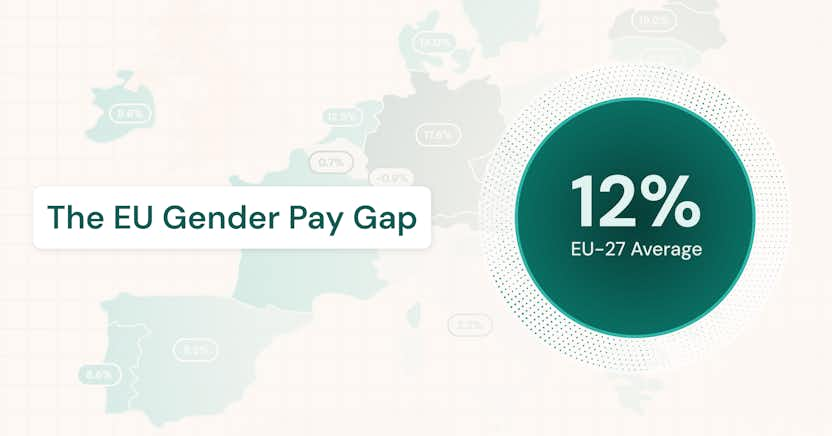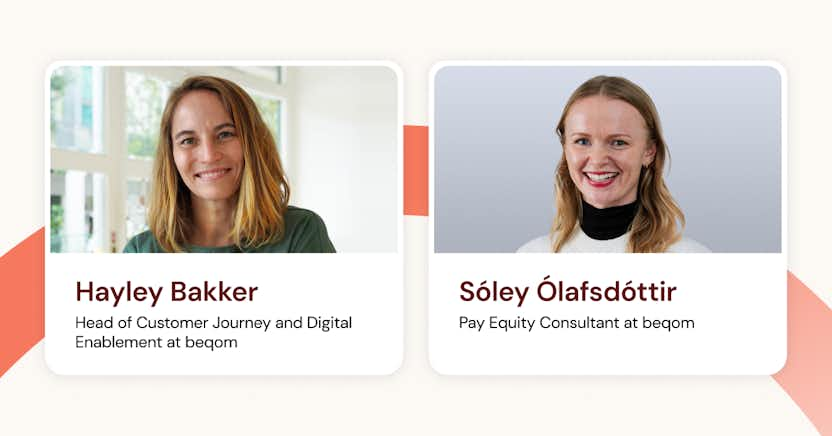Strategic Workforce Analytics: Benefits, Applications, and Future Trends

Learn more about the following beqom products
As businesses face mounting pressure to drive growth and foster innovation, the secret to long-term success is becoming clear: an empowered, diverse, and fairly treated workforce. Strategic workforce analytics is emerging as the game-changer, unlocking the data-driven insights that turn this vision into reality.
Surprisingly, a staggering 82% of employees report feeling that their work environment is unfair, highlighting a critical gap that businesses need to address. So, what do employers need to do to achieve a thriving workforce where everyone feels valued? It all starts with gaining a deep insight into demographic diversity and compensation within their teams.
This article explores the key components, benefits, applications, and future trends of workforce analytics and offers a comprehensive guide to harnessing its power in today's workplace.
What is workforce analytics?
Gartner defines workforce analytics as “an advanced set of data analysis tools and metrics for comprehensive workforce performance measurement and improvement.” This involves collecting and analyzing HR and operational data to make informed decisions about talent acquisition, pay equity, employee performance, retention, and overall workforce planning.
What should workforce analytics measure?
In workforce analytics, the metrics you measure should align with your organization’s goals, ranging from improving employee engagement to optimizing productivity. Here are some of the key components of workforce analytics:
- Data collection and analysis: Effective labor market analytics depends on gathering accurate data from various sources, such as HR systems, surveys, and operational databases.
- Utilization of HR and operational data: It encompasses employee demographics, performance metrics, compensation and rewards, and other relevant information.
- Predictive modeling and forecasting: Predictive HR analytics and forecasting models help anticipate employee turnover, optimize goal management, enhance reward systems, and proactively develop future-oriented strategies.
More specifically, here are key categories of metrics that organizations should track:
1. Talent acquisition metrics
- Time to hire: Measures the time it takes to fill a position from job posting to offer acceptance.
- Cost per hire: The total cost involved in hiring a new employee, including advertising, recruitment, and onboarding expenses.
- Quality of hire: Assesses the performance of new hires based on their contributions within a specific time frame, such as the first six months.
- Source of hire: Identifies which recruitment channels (e.g., job boards, referrals, agencies) yield the most successful candidates.
2. Employee engagement and retention metrics
- Employee turnover rate: Tracks the percentage of employees leaving the company during a specific period.
- Employee net promoter score (eNPS): Measures employees’ willingness to recommend their workplace to others, indicating overall satisfaction.
- Absenteeism rate: The frequency and duration of employee absences, which can signal disengagement or poor well-being.
- Voluntary vs. involuntary turnover: Differentiates between employees who leave by choice and those terminated by the company.
3. Fairness and diversity metrics
- Workforce Demographics: Tracks diversity in terms of gender, race, ethnicity, age, and more.
- Pay Equity: Compares compensation levels across different demographics to identify and address pay disparities.
- Diversity in Leadership: Measures the representation of different demographic groups in management and executive roles.
- Promotion and Career Progression Rates: Tracks the rate at which various employee demographics are promoted compared to others.
4. Productivity and performance metrics
- Revenue per employee: Assesses the company's revenue generated for each employee, indicating overall workforce productivity.
- Performance ratings: Aggregate data from performance reviews to identify top performers, underperformers, and overall team effectiveness.
- Project completion rates: Tracks the efficiency of teams and employees in delivering projects on time and within budget.
5. Learning and development metrics
- Training effectiveness: Measures the impact of training programs on employee performance and engagement.
- Skill gap analysis: Identifies areas where employees lack skills that are critical for organizational growth.
- Internal mobility rate: Tracks the number of employees promoted or transferred to new roles internally, a sign of career development and satisfaction.
6. Compensation and benefits metrics
- Total compensation expense: Tracks the company’s total spend on employee compensation, including salaries, bonuses, and benefits.
- Compensation competitiveness: Compares your pay packages to industry benchmarks to ensure they remain competitive.
- Benefits utilization: Measures how often employees take advantage of offered benefits, such as health insurance, wellness programs, and retirement plans.
7. Workforce planning metrics
- Workforce turnover forecast: Uses historical turnover data to predict future workforce needs and hiring requirements.
- Headcount growth rate: Measures the rate at which the workforce is expanding or contracting, indicating organizational growth or shrinkage.
- Succession planning coverage: Tracks the percentage of key roles with a succession plan in place.
8. Employee well-being metrics
- Work-life balance satisfaction: Surveys employees to gauge how well they balance professional and personal lives.
- Health and wellness program participation: Tracks participation in programs that support employee well-being, such as fitness programs or mental health services.
- Burnout rate: Measures signs of employee burnout, such as increased absenteeism or reduced productivity, which can harm engagement and performance.
By measuring these metrics, organizations can gain actionable insights to make strategic decisions that enhance employee experience, improve operational efficiency, and support overall business goals.
Benefits of workforce analytics
Let’s look at some of the benefits that come with using a workforce planning and analytics solution.
Improved decision-making
Workforce analytics provide leaders with actionable insights, enabling them to make informed decisions based on data rather than intuition alone. This leads to more accurate forecasting, better resource allocation, and enhanced strategic planning. Data-driven decisions, coupled with the company’s own predictive models, empower leaders to immediately address issues before they escalate and proactively optimize their workforce strategies.
Enhanced employee performance
Investing in performance management software gives organizations the opportunity to monitor and evaluate employee performance more effectively. This helps identify strengths and areas for improvement in the form of tailor-made bonus programs and improved productivity. As a result, managers observe improved employee retention efforts and team morale.
Greater insights into workforce trends and behaviors
Spotting emerging trends and hiring tendencies empowers leaders to navigate change with more certainty and a data-driven approach. Equipped with a better understanding of real-time workforce dynamics, decision-makers can swiftly develop a strategy for addressing current and future challenges.
Ensuring fair compensation and pay equity compliance
Recent regulations regarding pay transparency have emerged across the US, Europe, and other global regions, as governments worldwide strive to address pay equity, particularly in relation to gender, racial, and ethnic wage gaps. Workforce analytics play a critical role in identifying pay disparities and implementing equitable compensation practices. These tools, often used in tandem with professional compensation management software, support organizations in complying with diverse regulatory frameworks and fostering fairness across their global workforce.
Examples of workforce analytics in action
The different types of workforce analytics and planning have many applications for modern businesses. Here are the most popular examples of HR data analysis and prediction integrated into HR processes.
Talent acquisition
Analytics can significantly improve the hiring process by identifying the most effective recruitment channels, predicting candidate success, and reducing time-to-hire. For instance, a company using predictive analytics might discover certain correlations in talent dynamics or that candidates from specific universities have higher retention rates. In talent acquisition, most companies analyze key performance indicators (KPIs) like time and cost per hire, as well as the effectiveness of recruitment channels.
Yet, workforce analytics can go a few steps beyond that. In particular, by profiling successful candidates and anticipating future workforce needs. Google, a leader in tech and data-driven practices, has been a pioneer in using predictive analytics throughout its hiring and employee management processes to optimize how they attract, retain, and develop top talent.
Employee engagement and retention
Workforce analytics are all about revealing patterns. When it comes to talent retention, they can be used to measure satisfaction and identify turnover risk factors. For example, IBM analyzes data patterns to predict when employees will quit, which allows them to intervene and prevent a negative turn of events.
A comprehensive HR analytics tool allows you to track skill development and identify training needs, driving employee engagement and satisfaction. Additionally, these insights can help create personalized development plans, further enhancing retention efforts by aligning employee growth with company goals.
Performance management
Data-driven performance reviews and career development plans enhance employee growth and productivity. A company might use workforce analytics to identify patterns that lead to high performance and those that hinder employees’ potential. For instance, Standard Bank used beqom’s performance analytics solutions to create capability and promote career growth from within.
Another example is Unilever, one of the world's leading consumer goods companies, which uses AI and digital technology to better understand employees' skills and potential skill gaps in the future. One of the main capabilities that workforce analytics software offers is to identify skill gaps and measure performance. It helps managers in building a high-performance culture based on data.
Diversity and inclusion
A recent study found that nearly 80% of employees place high importance on Diversity, Equity, and Inclusion (DEI). Comparing and analyzing historical data allows companies to project their diversity metrics in the near and distant future.
Moreover, workforce analytics software helps organizations achieve their DEI goals by driving initiatives for a more inclusive workplace. It is a straightforward way of strengthening their commitment to Corporate Social Responsibility. In addition, employers can also spot recruitment gaps and hiring opportunities, adjusting HR strategy accordingly.
Pay prediction
Making informed salary decisions is the foundation of successful compensation management. Implementing AI-driven models and customizable frameworks can enhance the process and make pay prediction a top application of workforce analytics. Such solutions enable precise predictions for salary adjustments and merit increases, ensuring employee rewards align with company goals and market standards.
This way, you keep top performers in-house and give your employer brand a boost. Thanks to AI and automation, this is all done with precision, accuracy, and efficiency, supported by real-time updates.
How to stay abreast of current trends in workforce analytics
Predictive workforce analysis is the modern-day equivalent of a crystal ball. It gives you a sneak peek into the future, backed by data rather than intuition. The field is estimated to reach approximately $3.6 billion by 2025. Here is how to jump on the current trends to drive organizational growth.
Integrate AI and machine learning
Advanced technologies like AI and machine learning are revolutionizing workforce analytics. AI acts as a catalyst, streamlining large, time-consuming processes such as big data analysis, predictive modeling, and personalization based on predefined criteria. Thus, HR professionals can focus on strategic decision-making rather than manual data crunching.
Take advantage of automating manual tasks, such as data collection and cleansing, and let AI free up your time and resources for more complex HR capabilities. Go a step beyond and use machine learning models to personalize employee experiences. This will allow you to tailor development programs based on performance patterns.
Implement real-time analytics for faster decision-making
Real-time analytics empower managers to make faster, data-backed decisions. beqom clients have successfully integrated real-time data analysis into compensation management, enabling swift and confident pay decisions for new hires, merit increases, and bonus allocations.
Analytics tools can provide real-time dashboards for compensation, performance, and engagement metrics. Another important aspect of integrating real-time data is to properly train managers on using these tools. Finally, regularly review the impacts of real-time data analysis and fine-tune strategies accordingly.
Prioritize employee well-being with data insights
According to Deloitte, 78% of companies recognize the close link between employee performance and mental well-being. Implementing workforce analytics takes this understanding beyond traditional employee well-being programs and annual surveys. An example of this is companies that perform sentiment analysis.
Companies can collect real-time feedback from employees to generate reports on their emotional state. The availability of such systematized insights makes it easier to monitor and support employees' mental health in a more systematic way. Develop targeted well-being initiatives based on the data collected, and ensure they address the root causes of disengagement or burnout.
Leverage predictive and prescriptive analytics
The rise of forward-looking analytics in HR allows companies to anticipate challenges and opportunities. Predictive models help in labor market planning, while prescriptive analytics provide actionable recommendations for optimizing HR strategies, including the allocation of merit pay. In addition, these models can predict employee turnover, enabling companies to proactively implement retention strategies.
Predictive analytics and forecasting models can help you anticipate trends and proactively strategize. To accomplish this, invest in predictive modeling software that will successfully integrate with your HR systems. Make sure to review reports regularly to adjust compensation and performance strategies.
Overcome challenges in workforce analytics integration
Workforce planning and analytics offer employers significant opportunities to optimize their operations. However, like any solution, they come with certain limitations. Here are the key considerations to keep in mind before adopting workforce analytics software.
Ensure data privacy and security compliance
Ensuring compliance with data protection regulations is paramount when handling employee data. Implement robust encryption protocols for all data collected and stored. This will safeguard sensitive information and maintain employee trust. Complement this with strict access controls and ongoing data security training.
Improve the quality and accuracy of data
Reliable analytics depend on accurate data. For starters, you should conduct regular data audits to identify and correct inaccuracies. To speed up this process, deploy automated error-checking tools. Finish off by introducing regular employee training on data entry best practices. As a result, you will reduce human error and ensure all data is clean and accurate from the start.
Manage change effectively
Adopting new technologies can meet resistance. Start with small-scale implementations that demonstrate immediate benefits to build confidence across the organization. Involve employees through training and soliciting feedback. Successful implementation requires clear communication and showcasing the value of analytics to stakeholders. Focus on demonstrating the long-term benefits and impact on the overall work environment.
Future outlook
Workforce planning and analytics solutions are here to stay. Moreover, they will continue to evolve to better serve organizational goals, recognizing that people are a business's greatest asset. Here are our predictions about the future of workforce analytics.
Emerging technologies
Emerging technologies like machine learning, AI, and blockchain are driving significant innovations in the HR industry, fundamentally altering how workforce analytics operates. These technologies enable better data analysis, enhanced security, and more efficient process automation. They are applied in various HR functions, such as hiring, employee retention, and workforce management, enabling more accurate operations.
Blockchain enhances data security and transparency, ensuring sensitive employee information is handled with the utmost integrity. As these technologies continue to evolve, they will unlock new possibilities in predictive analytics, personalized employee experiences, and streamlined operations, making them indispensable tools for future workforce management.
Evolving workforce dynamics
Changes in employment trends, such as remote work and the growing digitalization of many sectors, will impact workforce analytics. As hybrid work models become more common, organizations increasingly rely on performance analytics to monitor productivity, engagement, and well-being across diverse work environments. These analytics tools are evolving to accommodate both in-office and remote workers with a comprehensive view of the workforce regardless of location.
Even smaller or mid-sized companies, which also are embracing these trends, can greatly benefit from implementing workforce analytics software to maintain productivity, ensure employee satisfaction, and manage a more flexible workforce. This shift is likely to increase the adoption of analytics tools among smaller businesses as they seek to remain agile and competitive in a rapidly changing work landscape.
Leverage workforce analytics with beqom
Strategic workforce analytics is a powerful tool that enables organizations to optimize talent management, improve employee satisfaction, and future-proof business success. By implementing AI models, data, and advanced analytics, companies can gain valuable insights, ensure fairness, and make informed decisions that enhance their workforce and performance. Applications range from talent acquisition to performance management and pay prediction.
If you are ready to empower your workforce and champion fairness through straightforward and compliant software, get in touch with us today to schedule a demo and learn more about our Pay Management solutions.







